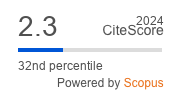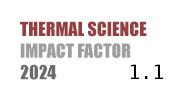THERMAL SCIENCE
International Scientific Journal
PHOTOVOLTAIC MODULE TEMPERATURE ESTIMATION UNDER VARIOUS ENVIRONMENTAL CONDITIONS: PRELIMINARY EXPERIMENTAL AND THEORETIC STUDY
ABSTRACT
The most of the solar radiation that reaches PV (module is transformed into the heat and partly is transformed into electricity. This causes an increment in the PV module temperature which leads to a decrease in its electrical efficiency. PV module temperature significantly depends on environmental factors such as solar radiation, air temperature and wind velocity. An overview of different empirical models for the estimation of PV module temperature using measured weather data is presented. The obtained results were compared with the measured data of the PV module temperature at the experimental set-up with the aim of preliminary analyzes which empirical model is optimal for analyzed geographical and climate location. Empirical models were evaluated into two categories: models that take into account wind velocity and those that do not. Analyses show that average temperature difference between measured values of the PV module temperature and the values predicted by the empirical models that do not consider wind velocity is 13.37°C and for models that do is 7.40°C. This proves that is very important to consider the effect of wind on PV module temperature. Analyzing obtained data, it can be concluded that temperature of the PV module is above 25 °C for whole measured period with significant impact of meteorological parameters.
KEYWORDS
PAPER SUBMITTED: 2024-12-24
PAPER REVISED: 2025-02-25
PAPER ACCEPTED: 2025-03-01
PUBLISHED ONLINE: 2025-04-05
THERMAL SCIENCE YEAR
2025, VOLUME
29, ISSUE
Issue 5, PAGES [3367 - 3376]
- ***, Renewables 2023 - Analysis and forecast to 2028, International Energy Agency Report, 2024
- ***, REPowerEU Plan, European Commission, 2022
- Akrami, E., et al., Integrated an Innovative Energy System Assessment by Assisting Solar Energy for Day and Night Time Power Generation: Exergetic and Exergo-Economic Investigation, Energy Conversion and Management, 175 (2018), Sept., pp. 21-32
- Aslan, G., et al., Impact of Harsh Weather Conditions on Solar Photovoltaic Cell Temperature: Experimental Analysis and Thermal-Optical Modelling, Solar Energy, 252 (2023), Mar., pp. 176-194
- Ahmed, H., et al., Experimental and numerical investigation for PV Cooling by Forced Convection, Alexandria Engineering Journal, 64 (2023), Feb., pp. 427-440
- Adefarati T., Bansal R., Reliability and Economic Assessment of a Microgrid Power System with the Integration of Renewable Energy Resources, Applied Energy, 206 (2017), Nov., pp. 911-933
- ***, EU Solar Energy Strategy, European Commission, Brussels, 2022
- ***, The future of Solar energy, MIT, 2015
- Valencia-Caballero, D., et al., Performance Analysis of a Novel Building Integrated Low Concentration Photovoltaic Skylight with Seasonal Solar Control, Journal of Building Engineering, 4 (2022), 104687
- Strielkowski, W., Renewable Energy Sources, Power Markets, and Smart Grids, in: Social Impacts of Smart Grids, Elsevier, Amsterdam, The Netherlands, 2020, pp. 97-151
- Nouar, A., Methodology for Predicting the PV Module Temperature Based on Actual and Estimated Weather Data, Energy Conversion and Management, 14 (2022), 100182
- Santiago, I., et al., Modelling of Photovoltaic Cell Temperature Losses: A Review and A Practice Case in South Spain, Renewable and Sustainable Energy Reviews, 90 (2018), July, pp. 70-89
- Sharaf, M., et al., Performance Enhancement of Photovoltaic Cells Using Phase Change Material (PCM) in Winter, Alexandria Engineering Journal, 61 (2022), 6, pp. 4229-4239
- Gurbuz, H., et al., Experimental Investigation on Electrical Power and Thermal Energy Storage Performance of a Solar Hybrid PV/T-PCM Energy Conversion System, Journal of Building Engineering, 69 (2023), 106271
- Yoong, C. B., Optimal Orientation and Tilting Angle of PV Panels Considering Shading and Temeprature effects, Ph. D. thesis, Lee Kong Chian Faculty of Engineering and Science Universiti Tunku Abdul Rahman, Sungai Long, Malaysia, 2023
- Rahman, M. M., et al., Effects of Operational Conditions on the Energy Efficiency of Photovoltaic Modules Operating in Malaysia, Journal of Clean Production, 164 (2017), Feb., pp. 1474-1485
- Fouad, M., et al., An Integrated Review of Factors Influencing the Perfomance of Photovoltaic Panels, Renewable and Sustainable Energy Reviews, 80 (2017), Dec., pp. 1499-1511
- Nezamisavojbolaghi, M., et al., The Impact of Dust Deposition on PV Panels' Efficiency and Mitigation Solutions: Review Article, Energies, 16 (2023), 16, pp. 2-19
- Gallardo-Saavedra, S., Karlson B., Simulation, Validation and Analysis of Shading Effects on a PV System, Solar Energy, 170 (2018), Aug., pp. 828-839
- Conceicao, R., et al., Soiling Effect in Solar Energy Conversion Systems: A Review, Renewable and Sustainable Energy Reviews, 162 (2022), 112434
- Korab, R., et al., A dynamic Thermal Model for a Photovoltaic Module under Varying Atmospheric Conditions, Energy Conversion and Management, 280 (2023), 116773
- Shadid, R., et al., Investigation of Weather Conditions on the Output Power of Various Photovoltaic Systems, Renewable Energy, 217 (2023), 119202
- Browne, M. C., et al., Heat Retention of a Photovoltaic/Thermal Collector with PCM, Solar Energy, 133 (2016), Aug., pp. 533-548
- Sohani, A., et al., Comparative Study of Temperature Distribution Impact on Prediction Accuracy of Simulation Approaches for Poly and Mono Crystalline Solar Modules, Energy Conversion and Management, 239 (2021), 114221
- Jaber, M., et al., Prediction Model for the Performance of Different PV Modules Using Artificial Neural Networks, Applied Sciences, 12 (2022), 12, 7
- Sulaiman, S. I., et al., Modelling of Operating Photovoltaic Module Temperature Using Hybrid Cuckoo and Artificial Neural Network, (Eds. Kim, Y. S., Kang, B. H., Richards, D.), Knowledge Management and Acquisition for Smart Systems and Services, PKAW 2014, Lecture Notes in Computer Science, Springer, Heidelberg, Germany, 2014
- Sohani, A., Sayyaadi, H., Employing Genetic Programming to Find the Best Correlation Predict Temperature of Solar Photovoltaic Panels, Energy Conversion and Management, 224 (2020), 113291
- Keddouda, A., et al., Photovoltaic Module Temperature Prediction Using Various Machine Learning Algorithms: Performance evaluation, Applied Energy, 363 (2024), 123064
- Zouine, M., et al., Mathematical Models Calculating PV Module Temperature Using Weather Data: Experimental Study, Proceedings, 1st International Conference on Electronic Engineering and Renewable Energy, ICEERE 2018, Lecture Notes in Electrical Engineering, Singapore, Singapore, 2019
- King, D. L., et al., Photovoltaic Array Performance Model, Sandia National Laboratories, Albuquerque, N. Mexico, USA, 2004
- Ross, R. G., Interface Design Considerations for Terrestrial Solar Cells Modules, Proceedings, 12th IEEE Photovoltaic Specialists Conference, Baton Rouge, La., USA, 1976
- Schott, T., Operation Temperatures of PV Modules: A Theoretical and Experimental, Proceedings, 6th EC Photovoltaic Solar Energy Conference, London, UK, 1985
- Lasnier, F., Ang, T. G., Photovoltaic Engineering Handbook, Taylor and Francis, New York, USA, 1990
- Mondol, J. D., et al.,Comparison of Measured and Predicted Long Term Performance of Grid a Connected Photovoltaic System, Energy Conversion and Management, 48 (2007), 4, pp. 1065-1080
- Skoplaki, E., et al., A Simple Correlation for the Operating Temperature of Photovoltaic Modules of Arbitrary Mounting, Solar Energy Materials and Solar Cells, 92 (2008), 11, pp. 1393-1402
- Kamuyu, C. L. W., et al., Prediction Model of Photovoltaic Module Temperature for Power Performance of Floating PV, Energies, 11 (2018), 2, 447

